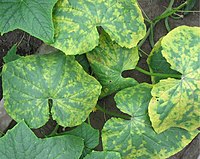
Photo from wikipedia
Pea (Pisum sativum L.) is an economically important legume crop that is commonly used as dry beans, fresh peas, pods and shoots (Guo et al. 2009). Pea enation mosaic is… Click to show full abstract
Pea (Pisum sativum L.) is an economically important legume crop that is commonly used as dry beans, fresh peas, pods and shoots (Guo et al. 2009). Pea enation mosaic is an important virus disease of pea caused by two viruses in an obligate symbiosis, pea enation mosaic virus 1 (PEMV-1, Enamovirus, Luteoviridae) and pea enation mosaic virus 2 (PEMV-2, Umbravirus, Tombusviridae) (Hema et al. 2014). In November 2019, foliar yellow mosaic and vein enations symptoms were observed from pea plants in five fields of Honghe autonomous prefecture, Yunnan province, China. Incidence of symptomatic plants ranged from 20 to 40% and was distributed in both small and large fields. Leaves with typical virus-like symptoms were collected from five symptomatic pea plants in two fields and used for total RNA extraction. The five extracts of equimolar quantities were pooled into a sample and subjected to High Throughput Sequencing (HTS) by Illumina HiSeq system. Analyses of raw RNA reads were performed using CLC Genomics Workbench 12 (Qiagen). A total of 60,009,746 RNA reads were obtained from the sample, and de novo assembly of the reads using the CLC Genomics generated 88,105 contigs. BLASTN searches revealed the presence of contigs with high similarities to PEMV-1, PEMV-2, Pea seed-borne mosaic virus, and Bean yellow mosaic virus. To confirm the presence of PEMV-1 and PEMV-2 in the samples, two virus-specific primer pairs were designed based on the contig sequences obtained by HTS in this study. Primer pairs PEMV-1F/PEMV-1R (5'-ATGCCGACTAGATCGAAATC-3'/5'-TCAGAGGGAGGCATTCATTA-3') that flank the cp gene of PEMV-1 and PEMV-2F/PEMV-2R (5'-ATGACGATAATCATTAATG-3'/5'-TCACCCGTAGTGAGAGGCA-3') that target the ORF3 region of PEMV-2 were used to amplify the two viruses in RT-PCR. DNA fragments of the expected sizes (PEMV-1, 570 bp; PEMV-2, 693 bp) were amplified from all five samples. The RT-PCR products were cloned and sequenced. Sequence analysis showed that the 570-bp amplicon (MT481989) shared the highest nucleotide sequence identity of 98.95% with PEMV-1 (Z48507), while the 693-bp fragment (MT481990) had the highest nucleotide sequence identity of 97.4% with PEMV-2 isolate JKI (MK948534). One gram of the symptomatic leaves from each of the five plants was homogenized with 5 mL of 0.01 M phosphate-buffered saline (PBS buffer), pH 7.0. Each of the resulted saps was used to inoculate onto five healthy pea seedlings. A total of 25 healthy pea seedlings were inoculated, and 16 inoculated plants developed yellowing and mottling at 10 days post inoculation (dpi); no symptoms were observed on control plants inoculated only with PBS buffer. The formation of the typical enation was observed along the veins of lower side of the symptomatic leaves of the inoculated plants at 30 dpi. PEMV-1 and PEMV-2 infection were confirmed by RT-PCR assays using the specific primer pairs described above. Although the presence of the pea enation mosaic virus complex was suspected in China based on symptomatology (Brunt et al. 1997), to our knowledge, this is the first molecular confirmation of PEMV-1 and PEMV-2 occurrence in China. The co-infection of PEMV-1 and PEMV-2 usually cause severe yield losses; therefore, integration of detection and control measures is important in pea production regions where the two viruses occurred.
Journal Title: Plant disease
Year Published: 2020
Link to full text (if available)
Share on Social Media: Sign Up to like & get
recommendations!